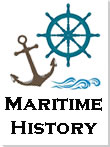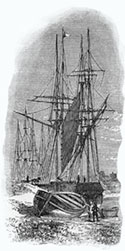Maritime History of Newport
By Peter Brown
© Peter Brown 2024
Piracy
Piracy is an act of robbery or criminal violence by ship or boat-borne attackers upon another ship or a coastal area, typically with the goal of stealing cargo and other valuable goods but also taking captives. A common problem when dealing with the subject is the distinction between pirates and privateers, who were engaged in similar work but operated under a state licence during times of war.[1]
In the mid-15th century, there was an increase in attacks on commercial vessels by Severnside pirates, mainly sailing out of Pembroke and Ilfracombe, and by pirates from Brittany and Spain who occasionally sailed into the Severn.[2]
In the early part of the 16th century, William Chick was a notorious pirate in the Bristol Channel. He appears in the records of the Star Chamber and is described as “the chief champion amongst them”, and when he came in the “companye of the pyratts from Bristol to Cardiff–saith that he came over at the passinge of Auste and from thens he came by lande to this towne.”[3]
The Elizabethan State Papers record the pirates John Callis (or Callice), Courte Heggenbroughe and their accomplices, who brought one of their prizes up the river Usk in November 1575. John Croft was sent from Hampton Court to apprehend them, with a Queen’s Commission, and heard in Newport that they were “in Penarthe rode before Cardiffe, with divers prizes.” He asked the Mayor of Bristol for help but did not get it. At the Penarth Road in Cardiff, he saw two prizes:[4]
one taken by a Scottish man (as it was recorded) laden with sackes (wines) bastardes (sugar) figges and resinges, and the other taken by Callis, laden with salmon, hearings and Manchester kersies (coarse woollen cloth), having 12 or 13 Scottish men aborde beinge owners and mariners thereof and yet kept prisoners under the hatches.
Croft did receive help from Sir William Morgan (c.1542-83) of Langstone and Pencoed, a relative of the Morgans of Tredegar who had recently been appointed Vice-Admiral for South Wales.[5] Morgan’s men boarded Callis’s prize and sailed it to the mouth of the Usk, but once there, Morgan refused to cooperate with the Commission, and Croft wrote to the justices of the peace for Monmouthshire demanding that they intervene regarding the prize and the “12 or 16 of Callises men” aboard. On the following day, the prize was taken a mile nearer to Newport, but Croft still received no help from Morgan or the Mayor for the 40 men he requested. It seems that they were keen to benefit from the impounded ships themselves, as Croft could not exercise his powers under the Crown.[6] After 4 days, Croft left, bemoaning that Morgan’s men:[7]
wente dailie and nightlie aborde the prise, in certen botes, with victualles, and although I caused the Myor of Newporte to Chardge them in her majesties name to stay from goinge aborde the said prise (hopinge thereby to have donne the better service) which they did not only willfully disobeye but also very disorderlie conveyed the goodes by daie and night in lighters and botes to places unknowen to me, and did not unlade the same at the Towne of Newporte whereby inventorie might be taken thereof, nor yet did they release the poore captives that were owners and maryners who lamentably cried for aide and relief.
Soon afterwards, in 1577, a Portuguese sailor named Simon Fferdinando was examined at Newport, where it appeared he had:[8]
piloted a ship whereof Callice was Master and one fferdinado ffilding captain. They met with a Portingall upon the costes of the land of Portingall and from him they toke about a 100 chestes of Sugar being part of his lading. And having gotten that prize they aryved with the same at the Rode of Pennarth besides Cardief in the countie of Glamorgan aboutes allhalontide last was two years, the said Callice the master and fferdinando the captayne made sale thereof to divers persons to whom certenly he knoweth not.
John Callis is an interesting character, and there is no doubt that he was a prominent figure in piracy along the South Wales coast in the 1570s. The State Papers contain many references to his activities and to the claims that people within the authorities protected him.[9] Other claims online are less reliable, although they state that he was born in Monmouthshire, was the son-in-law of Nicholas Herbert, and was hung after being refused in his offer to assist the authorities in return for a pardon.[10] The common claim (based on Wikipedia) that he was hung at Newport in 1576 is incorrect, as the following details confirm.
Three of the people involved in the cases from 1575-77 (see above) made a surprise appearance in the 1578 expedition to the Americas organised by Sir Humphrey Gilbert when it appears that the expedition included many pirates who were especially pardoned for the voyage.[11] Eleven armed ships and nearly 600 men were gathered at Plymouth for the expedition, but Gilbert’s chief associate, Henry Knollys, refused to acknowledge Gilbert’s authority and took several of the ships to the Spanish coast. His pilot was John Callis, the well-known pirate from the Bristol Channel. Gilbert set off from Plymouth on 19 November with seven ships:[12]
- the Anne Aucher, commanded by Gilbert, with Henry Pedly as Master.
- the Hope of Greenway had Carew Raleigh as Captain and Jacob Whidon as Master.
- the Falcon, a royal ship, was captained by Walter Raleigh with Simon Fernandez as Master.
- the Red Lion was captained by Miles Morgan, with John Anthony as Master.
- the Gallion, with Richard Udall as Captain and Kurt Heykenborow as Master.
- the Swallow, John Verney Master.
- the Squirrel, a small frigate.
Simon Fernandez, who had been held at Newport in 1577, was a Portuguese pilot familiar with the Indies route. Kurt Heykenborow had worked with Callis when he brought a captured ship into the Usk in 1575. Miles Morgan, who was from the Tredegar Park Morgans, was lost with the Red Lion on the voyage. Sir William Morgan of Langstone and Pencoed, a relative of the Morgans of Tredegar who had recently been appointed Vice-Admiral for South Wales, was expected to join the voyage but was stopped from doing so.
Piracy was still a major issue in the early 17th century, and many British sailors were engaged, some even sailing with crews from the pirate ports in North Africa; they were active in the Mediterranean and the Atlantic, as well as around the British coast.[13] In 1631, pirates from Algiers invaded the harbour village of Baltimore on the south coast of Ireland, taking all the villagers as captives.[14] More commonly, ships were attacked and taken or plundered, and in 1613-14, four “ships of war” were fitted out in Bristol to protect trade in the Bristol Channel. HMS Phoenix was sent into the Channel for a period, but on her departure, the pirates reappeared.[15]
In 1626, Charles I demanded from the Port of Cardiff an equipped 30-ton barque or pinnace but was told that the five suitable ships owned by the port had been captured by “pirates of Sallee” (Salé, a port in Morocco).[16] The port and its associated creeks contained only boats of 20 or 23 tons, used for trading cattle and sheep. We do not know what became of the Newport ‘Topmen’ recorded in the late 16th century, such as the Dragon (100 tons), the White Eagle (100 tons) or the Griffine (50 tons), or why they were not replaced by larger ships or available for these duties.[17] In 1636, four Turkish ships entered the Bristol Channel and captured 20 vessels.[18]
Lundy Island was a major centre for piracy in the 17th century, as it occupied a commanding position where ships entering the Bristol Channel could be attacked from a secure and remote base. In later years, smugglers used the island for the same reason. In 1627, a group known as the Salé Rovers (from Morocco) occupied Lundy for five years. Under the command of a Dutch renegade named Jan Janszoon, these Barbary Pirates made slaving raids embarking from Lundy and captured Europeans were held on Lundy before being sent to Algiers to be sold as slaves. From 1628 to 1634, in addition to the Barbary Pirates, the island was plagued by French, Basque, English and Spanish privateers, targeting the lucrative shipping routes passing through the Bristol Channel. Sir John Penington eventually ended these incursions, but the island still fell prey to French privateers in the 1660s and as late as the 1700s.[19] In 1636, Penington wrote to the Lords of the Admiralty to explain the advantages of the two Spanish ships he had captured when compared to the royal ships. Concerted action and the Government’s commitment to ending piracy brought results, with a sharp reduction in pirate activity around Britain after 1640.[20]
In 1640, Charles I introduced a 5% Algiers Duty on all exports and imports above the duty collected as Tonnage and Poundage. This was for the redemption of captives of Algerine and Barbary pirates, who roamed the seas widely and were active in the Bristol Channel. The duty was collected by Customs officials at the ports and transferred to the Chamberlain of the City of London.[21]
References
[1] Senior, Clive (1972) An Investigation of the Activities and Importance of English Pirates 1603-40, PhD thesis at the University of Bristol.
Online at: https://research-information.bris.ac.uk/ws/portalfiles/portal/34506574/544142.pdf
[2] Jones, Evan T. and Stone, Richard (2018) The World of the Newport Medieval Ship: Trade, Politics and Shipping in the Mid-Fifteenth Century, 102.
[3] Dawson, J. W. (1932) Commerce and Customs: A History of the Ports of Newport and Caerleon, 88-9.
Online at: https://archive.org/details/commerce-and-customs-newport
[4] Dawson, 89.
[5] https://www.historyofparliamentonline.org/volume/1558-1603/member/morgan-sir-william-1542-83
[6] Dawson, 89-90.
[7] Dawson, 90-1.
[8] Dawson, 91.
[9] https://www.british-history.ac.uk/cardiff-records/vol1/pp347-368#highlight-first
[10] https://www.historic-uk.com/HistoryUK/HistoryofWales/John-Callis-Callice-Welsh-Pirate/ ; https://www.walesonline.co.uk/news/local-news/cardiff-safe-place-britains-most-1815713
[11] Henry Knollys (d.1582).
Online at: http://www.berkshirehistory.com/bios/hknollys.html
[12] Quinn, David Beers (1940) The Voyages and Colonising Enterprises of Sir Humphrey Gilbert, Vol. 1, London: Hakluyt Society.
Online at: https://archive.org/details/in.ernet.dli.2015.99657/page/n5/mode/2up
[13] Senior.
[14] Ekin, Des (2008) The Stolen Village: Baltimore and the Barbary Pirates.
[15] Dawson, 19.
[16] Dawson, 18-19.
[17] Dawson, 12.
[18] Dawson, 19.
[19] https://en.wikipedia.org/wiki/Lundy
[20] Senior, 109-14.
[21] Dawson, 22.
Back to Index of Peter Brown's "Maritime History of Newport "

